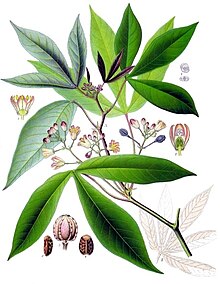Farine Pie
F A R I N E P I E
 |
| Farine Pie |
 |
| Farine Pie |
 |
| Farine Pie |
 |
| Farine Pie |
Ingredients
½ lb Farine
5 eggs
½ cup + 1 tablespoon sugar
¼ cup + 2 tablespoons butter
2 tablespoons flour
½ teaspoon nutmeg
½ teaspoon baking powder
1 teaspoon vanilla
1 lb chicken (boiled)
½ can Pet milk
½ - 1 cup of water
Method
1. Preheat oven to 350°.
2. Grease baking pan and set aside.
3. Boil chicken with water, celery, salt, garlic salt, thyme and pepper.
4. Combine milk and water.
5. Sift Farine and gradually add milk mixture; soak for a couple of hours (approximately 2-3). Add more milk as the Farine dries out within the soaking hours.
6. Cream butter and sugar.
7. Add eggs, then add it to Farine mixture.
8. Add vanilla.
9. Add dry ingredients.
10. Layer the bottom of the pan, add chicken and another layer on top.
Farine Pie was made and prepared by Shirley-Ann Pearman
Photography by Shirley-Ann Pearman
Recipe derived from Betty Ming’s Farine And Cassava Pie.
For all photos on Farine Pie please click on the photos to this post here at Facebook.
Farine Pie made in December 2017.
Other blog postings in reference to Christmas Pies as we call them in Bermuda.
Farine Pie made in December 2017.
Farina (Food)
Farina is a form of milled wheat often prepared as hot cereal. The word "farina" is Latin, meaning meal or flour. It is made from the germ and endosperm of the grain, which is milled to a fine consistency then sifted. Farina is a carbohydrate-rich food. When enriched, it is one of the best sources of dietary iron available, especially for vegetarian diets. Popular brands offer up to 50% of the recommended daily value of iron in a single 120-calorie serving. In commercially-available farina the bran and most of the germare removed. Cream of Wheat, Malt-O-Meal, and Farina Mills are popular brand names of breakfast cereal. To augment its mild taste, popular add-ins to cooked farina include brown sugar, maple, honey, nuts, cinnamon, butter, grated chocolate, jams, and salt.
Farina may also be cooked like polenta and farofa. It can also be used to prevent dough from sticking to baking surfaces via the baking process, leaving residual farina on the bottom of the final product.
Flour - Farine (Farine- (French))
Flour is a powder obtained by grinding and grinding cereals or other solid food crops, often seeds. Flour from cereals containing gluten , such as wheat , is one of the main elements of the diet of some peoples of the world. It is the basis of making breads , pastas , pancakes , pastries and many dishes .
The activity of processing the cereal into flour is called milling or milling . The miller is the transformer who exercises it. The place where wheat is grinded is the mill .
The grain of wheat is made up of three parts: the almond, the seed and the husk. The seed is thrown or mixed into the envelope to make up the big sounds and fine sounds, which go into the composition of the loaves to the sound or complete. The kernel, heart of the grain of wheat, is ground to obtain the white flour. The milling industry adds additives to modify its quality.
In the past, flours were aged before use to oxidize 1 , the maturation of a flour making it whiter naturally. Today, flours are often bleached with bleaches or additives that speed up their maturation (eg potassium bromate 2 , chlorine dioxide 2 , or ascorbic acid 3 ) .
Cassava
| Cassava | |
|---|---|
 | |
| Leaves of the cassava plant | |
 | |
| A manioc tuber | |
| Scientific classification | |
| Kingdom: | Plantae |
| Clade: | Angiosperms |
| Clade: | Eudicots |
| Clade: | Rosids |
| Order: | Malpighiales |
| Family: | Euphorbiaceae |
| Genus: | Manihot |
| Species: | M. esculenta |
Manihot esculenta, commonly called cassava (/kəˈsɑːvə/), manioc,[2] yuca, macaxeira, mandioca, aipim and Brazilian arrowroot,[citation needed] is a woody shrub native to South America of the spurge family, Euphorbiaceae. It is extensively cultivated as an annual crop in tropical and subtropical regions for its edible starchy tuberous root, a major source of carbohydrates. Though it is often called yuca in Spanish and in the United States, it differs from yucca, an unrelated fruit-bearing shrub in the family Asparagaceae. Cassava, when dried to a powdery (or pearly) extract, is called tapioca; its fried, granular form is named garri.
Cassava is the third-largest source of food carbohydrates in the tropics, after rice and maize.[3][4] Cassava is a major staple food in the developing world, providing a basic diet for over half a billion people.[5] It is one of the most drought-tolerant crops, capable of growing on marginal soils. Nigeria is the world's largest producer of cassava, while Thailand is the largest exporter of dried cassava.
Cassava is classified as either sweet or bitter. Like other roots and tubers, both bitter and sweet varieties of cassava contain antinutritional factors and toxins, with the bitter varieties containing much larger amounts.[6] It must be properly prepared before consumption, as improper preparation of cassava can leave enough residual cyanide to cause acute cyanide intoxication,[7][8] goiters, and even ataxia, partial paralysis, or death. The more toxic varieties of cassava are a fall-back resource (a "food security crop") in times of famine or food insecurity in some places.[7][6] Farmers often prefer the bitter varieties because they deter pests, animals, and thieves.[9]




0 Response to "Farine Pie"
Post a Comment